Hi! Have you ever heard of plastic and the problems associated with it in tourism and elsewhere? That’s what I’m talking about today: plastics. Let’s try to put the problem in context, compare some proposed solutions and see two practical aspects of plastic for those working in the tourism sector, particularly in hospitality.
My name is Sara, I am a consultant for the tourism sector and on this site, I talk about tourism, sustainability, theory and concrete practices to become a more sustainable operator.
Topics covered in this article!
From micro to maxi: we need to understand the scale of the problem.
- The first source of plastic waste: packaging;
- The second source of plastic waste: clothes;
- Products: plastics even in cosmetics.
- The hospitality sector and the solutions against the plastic problem.
The plastics problem has reached such a level that there are now plenty of studies pointing to catastrophic scenarios as the most feasible is up to 30 years (2050).
For example, the Washington Post article ‘By 2050, there will be more plastic than fish in the world’s oceans, study says‘ in January 2016 mentions the study ‘The New Plastics Economy Rethinking the future of plastics by the World Economic Forum‘.
The article ‘Humans are putting 8 million metric tons of plastic in the oceans – annually‘ mentions further studies carried out at the University of Georgia.
For a more recent mention, Greenpeace publishes in 2019 the report “THROWING AWAY THE FUTURE: HOW COMPANIES STILL HAVE IT WRONG ON PLASTIC POLLUTION “SOLUTIONS” from which I took the conclusions.
And the summer article in the magazine Yes! 2021 illustrates the plastic problem, its evolution and possible solutions.
It was this article and the coherence with the message coming out of the film Seaspiracy that inspired me to want to discuss the subject.
This article is not only about tourism because the problem of plastic is transversal and goes far beyond this sector. However, there is a specific section on what to do in the hospitality industry to help solve this situation.

How did we realise that plastic was becoming a problem?
Well, unfortunately, most of us realised it because it became apparent:
- on our streets,
- on our beaches,
- in the countryside,
- at the supermarket or in the biggest markets in our cities.
Until we realised that this disasterhas taken on enormous proportions in places thereticllly fsr from everything and everyone in the middle of the ocean: The Great Pacifc Garbage Patch
Actually, reports the YES! some people realised the dangers of plastics a long time ago (the 1960s and 1970s), but the industries linked to production (plastics and petrochemicals) immediately worked to shut down that kind of scientific research, for example threatening Edward J. Carpenter for his research on plastics in the 1970s. Carpenter published two landmark articles in the journal Science in 1972 and was among the first researchers to describe “plastic particles” in the oceans. Reference YES! 2021.
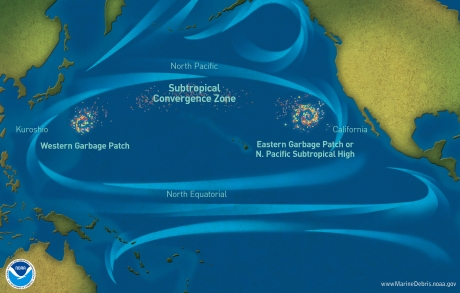
The Garbage patches are large areas of the ocean where litter, fishing gear and other debris, known as marine debris, collects. They are formed by rotating ocean currents called ‘gyres’. They can be thought of as large eddies that attract objects. Source marinedebris.noaa.gov
“Patch’ is a misleading name, leading many to believe that these are islands of rubbish. Instead, debris is scattered across the surface of the water and from the surface to the ocean floor. The debris varies in size, from largely abandoned fishing nets to tiny microplastics, which are pieces of plastic smaller than 5 mm. This makes it possible to navigate through some areas of the Great Pacific Garbage Patch and see very little or no debris.
The biggest problem and the main reason why the clean-ups by so many enthusiastic volunteers (including myself) are not enough is the fact that this is only the visible part of the problem. Microplastics, fragments of less than 5 millimetres, have been found not only in the sea but also in freshwater, soil and the air we breathe.
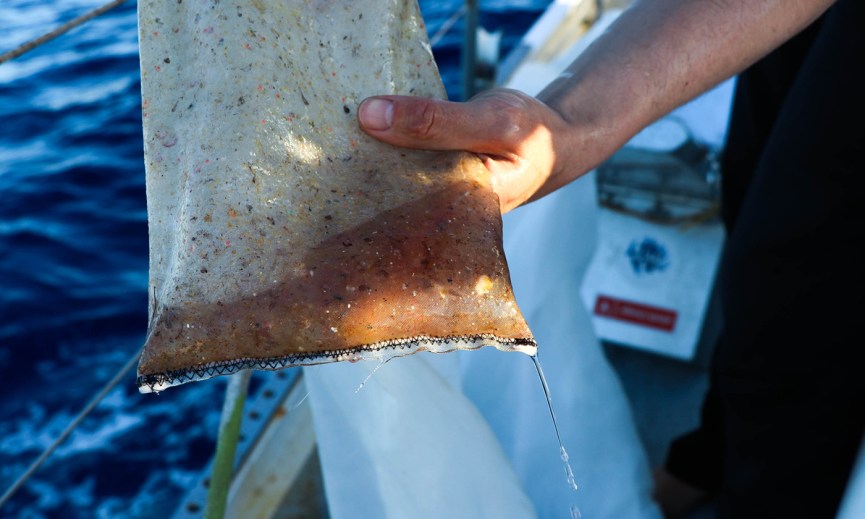
Know the problem… to face it
The first source of plastic waste
packaging and the compulsive use of disposables have, since about the 1960s, generated a change in the behaviour of society, which until then was used to reuse. (Source: Production, use and faith of all plastics ever made.)
The second source of plastic waste is clothes.
Of course, clothes are not even remotely comparable in quantity with the former, but they are in my opinion very important. First of all, we are talking about products that are in direct contact with our skin, and secondly, the ecological, economic and social impact of this sector is exorbitant. Particularly considering the fact that very often garment industries produce in poor countries and often this is the main source of income for many families.
Production processes and working environments must be under control in order to protect both consumers and producers in this sector, starting with the raw materials.
Source: Textile exchange_ Preferred Fiber & Materials Market Report 2021.
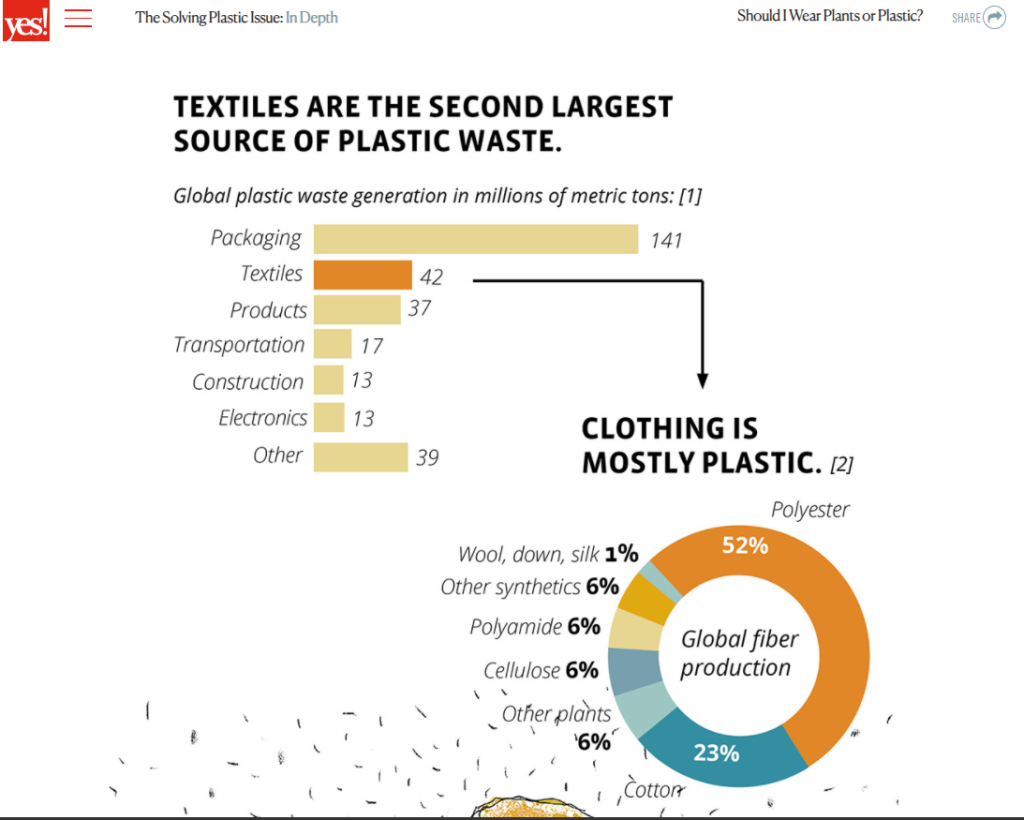
The infographic shows data from an interesting report by the Textile Exchange (Textile Exchange is a global non-profit creating leaders in the fibres and preferred materials industry).
Textile Exchange defines a preferred fibre or material as one that results in better environmental and/or social sustainability outcomes and impacts than conventional production.
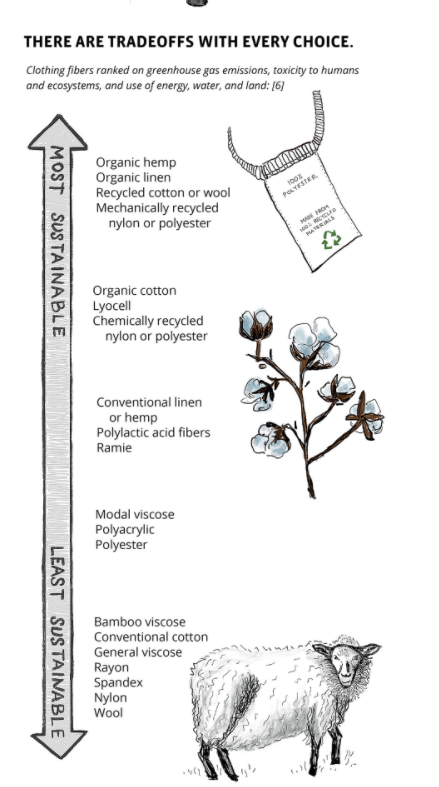
There are two main types of products containing plastics:
Plastic products that explicitly show the material they are made of
Products that contain plastic in a non-visible and not always explicit way.
The second group includes household care and cleaning products and cosmetics products that conceal plastic particles inside, often without people being aware of it.
The article Plastic in make-up, a change is needed in the Italian cosmetics sector by Greenpeace Italy and the report mentioned Il trucco c’è ma non si vede (The make-up is there but you can’t see it) show how even in Italy some of the most careful companies on the packaging side have made mistakes by using plastic in their products.
In 79% of the 672 products checked online, plastics were found, 38% of which were solid particles known as microplastics. The survey also revealed the massive use of polymers in liquid, semi-solid and soluble form, the effects of which on people and the environment are not yet fully known.
What can we do?
There are solutions to be adopted at different levels: from the multinational to the individual.
Since we cannot recycle everything (the percentages are very low! Around 9%) the only solution is to produce less.
Forget disposable for 95% of situations (in some medical cases it is not possible).
Every sector can contribute, starting with the multinationals that make food and drink produce useless, single-serving packaging.
The individual citizen can demand this change from the big companies and behave in a way that is consistent with the demand made of others and change his or her habits regarding use and throw-away. Reuse and bulk purchase should become our watchwords.

What can the hospitality sector do?
- Abolish plastic bottles for sale at the bar, keep glass bottles (returnable) and offer water bottles as an alternative to those looking for a small bottle for excursions.
- Evaluate feasible alternatives for breakfast that reduce single-serving products and the associated plastic wrapping.
- Analyse your own situation to see what alternatives are best for your guests. For example, is it feasible to replace soap in the bathroom with a refill dispenser (reducing the amount of shrink-wrapped soap that is never finished and therefore has to be thrown away)? What dispensers can be found?
My guests unfortunately were not able to use any type of dispenser without breaking, from the EKOLN porcelain ones from Ikea, to the tin ones, but not even the plastic ones (always better than the mono dose). But we don’t give up!
- Choose from the very few options available recycled plastic dispensers for shower foam or shampoo.
- Recycle, at least internally, the plastic.
- Try to give guests the option of sorting themselves, after 2 years we gave up because we had to sort paper, glass and plastic every day and the rest of the rubbish was always left in the wrong bins.
- Dedicate one moment a week to these topics to help interested guests learn more and to involve them in an awareness-raising action that can be shared.
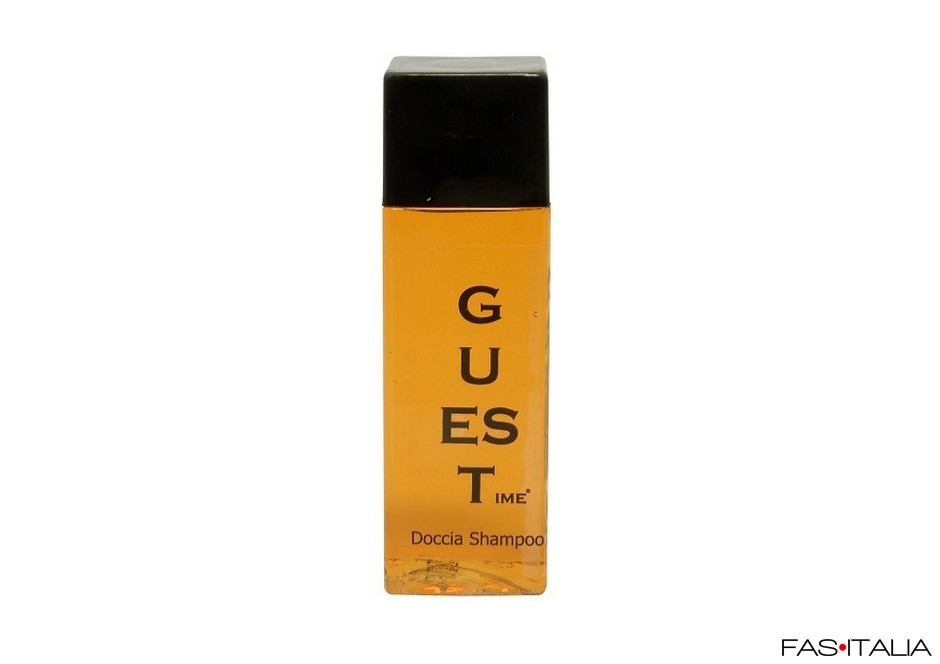
this was the first courtesy line used in the hotel
The best solutions we can (as a society) adopt are, in my opinion, suggested by Greenpeace
In general, it is necessary that those who put the largest quantities of disposable plastics on the global market, i.e. the large multinationals, immediately reduce their production of single-use plastics by investing in alternative solutions based on reuse and refill that do not involve the use of other disposable packaging, regardless of the type of material.
Specifically, large food and beverage companies need to prioritise reduction by committing publicly and immediately to eliminating single-use plastics, starting with the types of packaging that are redundant and most problematic for recycling, reducing the number of plastic packaging and containers placed on the market; investing in alternative delivery systems based on bulk and refill; and being transparent by publicly disclosing data on plastic production.
Too often multinational companies have passed the task to the individual and as explained above the desire of individuals to do better cannot justify a non-response from those who require the production of tonnes of single use wrapping for the delivery of their products.
Current recycling systems are not able to recover enough material to reduce the demand for virgin plastics and ensure adequate disposal of the increasing amount of waste produced. At European level, only 31% of the plastic waste collected in 2016 was actually recycled. For some truly recyclable plastics such as Polyethylene Terephthalate (PET) and High Intensity Polyethylene (HDPE) recycling rates are still appallingly low: only half of the PET sold is collected for recycling, and only 7% of the bottles collected for recycling are made into new bottles.
Much of the plastic packaging is subject to ‘downcycling’: instead of being used for new recycled plastic packaging, it is reprocessed into lower quality, non-recyclable products. Furthermore, according to the Greenpeace report, producing virgin plastics is often cheaper than producing recycled plastics, so it is easy to realise that even if some types of plastics are technically recyclable, it does not mean that they will be recycled because they are difficult to place on the market. Therefore, recycling can only be a partial and transitional solution to phase out packaging.
The report also explains in detail why alternatives such as bio-plastics and paper are not advisable as a long-term solution.
The only solution that everyone can continue is using reusable products. Yes! suggests us how to move from words to actions.
- Find out where you can find a shop or supermarket with bulk products and start going there. Slowly try out what you are curious about from household products to food.
- Find out where you can find a water shed and a milk shed – often we don’t even know we have them within walking distance of our homes.
- Find the weekly (or bi-weekly) market and discover what is being sold! In Como, for example, depending on the area, you can find the local producers’ market, the organic market or the normal market.
- Find out about these topics when you can and especially about your favourite brands.
- Ask your brands to do better and to do more.
Let me give you an example.
I’ve always loved Erbolario as a cosmetics brand, and for years I’ve been careful about my plastic consumption, for example by using glass bottles, flasks, etc. For about a year and a half I’ve been testing the use of organic and regular products. For about a year and a half I have been testing solid shampoos. I found an Erbolario shop in Como to whom I told about my interest and research and since this summer there is a solid shampoo that I have been experimenting with for a few days. Maybe it was accidental the arrival of the solid shampoo, but I am convinced that as individuals what we can do is to choose more carefully.
These days I will be sifting through my cosmetics, shampoos, etc. to check for the presence of plastic in them.
From my experience there is a gulf between what you can buy as a private citizen and what you can choose as a business, but things are improving even in this second case and also for the hotel I talk, ask and get informed as much as possible to find the best solutions for us, our guests and the environment.
The sources of information used are:
Sites for further information in Italian and English
- Great pacific garbage patch
https://theoceancleanup.com/great-pacific-garbage-patch/ https://marinedebris.noaa.gov/info/patch.html#5 - Le reti
https://www.theguardian.com/environment/2019/nov/06/dumped-fishing-gear-is-biggest-plastic-polluter-in-ocean-finds-report - Microplastica nei cosmetici
https://www.greenpeace.org/italy/storia/13064/plastica-nel-make-up-serve-una-svolta-del-settore-italiano-della-cosmesi/ - Report di Greenpeace (briefing in Italiano) https://www.greenpeace.org/static/planet4-italy-stateless/2019/10/7ad0fe02-greenpeace_ilpianetausaegetta_sintesi_ita.pdf
- Report completo in inglese
https://storage.googleapis.com/planet4-international-stateless/2019/09/8a1d1791-falsesolutions2019.pdf - National geographic
https://www.nationalgeographic.it/ambiente/2020/01/tutto-quello-che-ce-da-sapere-sullinquinamento-da-plastica - Textile exchange
https://textileexchange.org/textile-exchange-preferred-fiber-and-materials-market-report-2021/
I hope you enjoyed this article! Are you interested in this topic?
Please share your opinion, email me or write to me on social media. I always enjoy reading your comments!
Sara – tourism sector consultant
